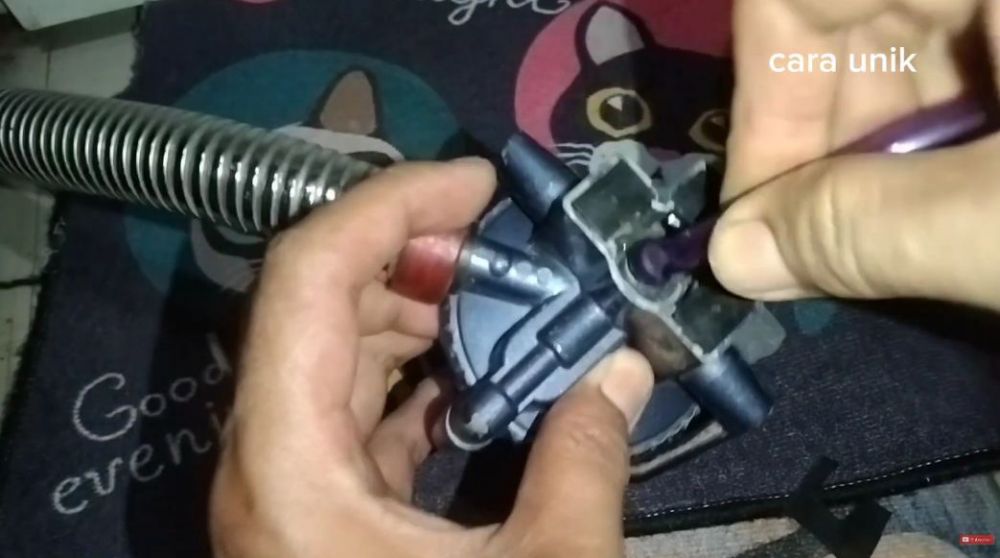foto: YouTube/CARA UNIK
Brilio.net - LPG gas cylinders are one of the fuels for lighting stove fires. The fire from this gas cylinder is then used for various cooking and household purposes. Therefore, gas cylinders are an important item that must always be full in order to be used.
When the gas runs out, the LPG cylinder will immediately be replaced with a new one. However, there is one problem that often occurs after replacing LPG gas cylinders. Even though a regulator has been installed, the gas cylinder sometimes leaks. This is indicated by a hissing sound coming from the end of the gas cylinder.
Indeed, there are several causes of leaks in LPG gas cylinders. One of them is a loose red rubber seal, so gas cannot flow properly to the regulator. So to overcome this, some people usually replace the red seal with a rubber band. After investigating, rubber bands can make gas flow perfectly and not leak.
However, in some cases, simply replacing the red seal with a rubber band is not effective. As a result, many people then look for other alternatives. One of them is what YouTube user CARA UNIK did. Through one of the uploaded videos, he admitted that he used other materials to fix the leaking LPG gas cylinder.
How to deal with leaking LPG gas cylinders.
As reported by BrilioFood on Wednesday (6/3), the materials used came from used goods, namely unused water hoses. It doesn't need to be long, just a few centimeters will be used to fix this leaking gas cylinder.

photo: YouTube/UNIQUE WAYS
To measure it more clearly, you can insert the end of the hose hole into the gas cylinder regulator. Make sure the hole size of the hose and regulator really fits. If it's too narrow, you can burn the end of the hose hole first. Then install it again until the hose can completely cover the end of the regulator.
Then, if the hole size feels right, remove the hose. Then cut the end of the hose so that it fits the length of the regulator hole. After that, reattach the hose to the regulator. Well, this regulator is ready to use.

photo: YouTube/UNIQUE WAYS
However, before attaching it to the gas cylinder, make sure the red seal (default) in the gas cylinder hole has been removed. Only then install this regulator as usual. In the video, YouTube user CARA UNIK claims that there was no hissing gas sound immediately after the regulator was attached to the gas cylinder. This indicates that the gas is no longer leaking, making it safe to use.

photo: YouTube/UNIQUE WAYS
In the video, YouTube user CARA UNIK also shows a stove that has been installed with the tube and regulator. When lit, the stove fire can come out perfectly. That way, the gas flow from the cylinder to the stove is also smooth.

photo: YouTube/UNIQUE WAYS
How? Easy enough, right? You can copy this trick if you experience the same problem. Basically, the used hose will block the gaps that cause gas leaks. Therefore, this trick is very effective to practice at home.
How to safely use LPG gas cylinders.
Using LPG gas cylinders safely is very important to prevent accidents and danger. Here are 9 safe ways to use LPG gas cylinders:
1. Tube position.
Place the LPG gas cylinder upright and on a flat, sturdy surface. Make sure the tube does not fall easily.
2. Ventilation.
Make sure the room where the gas cylinder is used is well ventilated to avoid potentially dangerous gas buildup.
3. Do not open fire near the cylinder.
Avoid open flames, including matches or electronic devices that have the potential to cause sparks, near gas cylinders.
4. Check for leaks.
Before using, check the LPG gas cylinder to ensure there are no leaks by using liquid soap on the connection and seeing if any gas bubbles come out.
5. Use the correct hose and regulator.
Make sure to use a hose and gas regulator that fits the cylinder and meets safety standards.
6. Store safely.
Store LPG gas cylinders in an upright position and away from direct sunlight or other heat sources.
7. Avoid shocks and impacts.
Take care of the LPG gas cylinder so that it is not exposed to shocks or impacts that could damage it.
8. Turn off the stove after use.
Make sure to turn off the stove after use and ensure there are no gas leaks.
9. Do not mix with other fuels.
Do not mix LPG gas with other fuels such as gasoline or diesel, because it can cause dangerous chemical reactions.
(brl/tin)